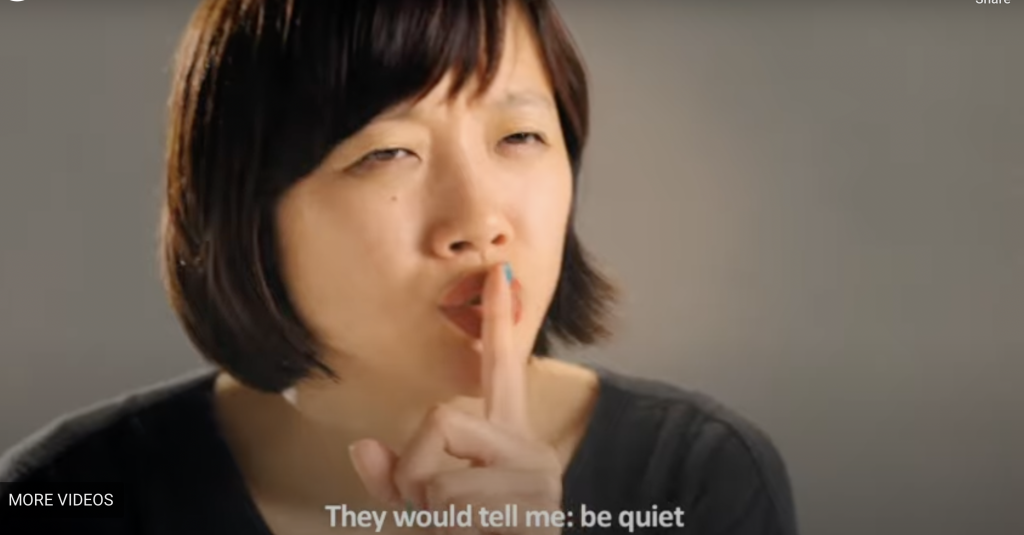Christine Sun Kim Nowness

The video commences with Christine Sun Kim getting ready at home and beginning her journey in a busy commute. The viewers only know that she is a deaf artist when she starts using sign language and subtitles. Not all disabilities are visible. Disability occurs in many forms – invisible/non-visible disabilities are impairments or health conditions that may not be immediately obvious.
Kim uses multiple “speaker cone” surfaces with objects to vibrate and create air disturbances, allowing her to experience and see sound. She uses the onomatopoeia sensory to bridge the gap between hearing and touch and visual. Although I can’t fully understand Kim’s disability, as a PoC dyslexic artist, my disability is invisible, and I use different techniques to overcome it in my daily endeavours. The video made me think about ways to deliver and structure my teaching to support students with potential hearing impairment or invisible/non-visible (undeclared).
6 responses to “Inclusive Practices Unit 1 Disability”
Thanks for sharing Freya! The visual data you have included in your reflection is really useful to see, albeit quite stark.
I was reading an article by Lynne Kendall recently (linked below!) which speaks to your comment on people potentially viewing disclosure of a disability or specific learning difference as inviting exclusion and stigmas from others. Interestingly this article speaks on the student experience and from the student viewpoint rather than the tutor.
It breaks it down into 3 themes..
1. Identifying with a disability
2. Barriers to participation
3. Assessment
Some students chose not to disclose their disability or learning difference through fear of stigma and limiting their career progression. Others chose not to disclose it because they didn’t view it as a disability but instead a condition, and viewed the term disability as something that ‘holds you back’. Interestingly then particular teaching and assessment methods seem to have almost forced students to disclose their disability or learning difference as they weren’t comfortable, often due to reading and writing or presentation speaking.
It would be interesting to know as a dyslexic tutor yourself and your positionality, if there are specific things you do within your teaching practice to make learning and assessment more accessible?
Higher Education and disability: exploring student experiences. – Lynne Kendall – https://www.tandfonline.com/doi/epdf/10.1080/2331186X.2016.1256142?needAccess=true&role=button
This is a very interesting series of reflections. I found the representation of Rebekah Ubuntu and their intersectionality enlightening, I was surprised that I hadn’t heard of their work as I’ve made an effort to expand the existing Sound and Music canon so I’m grateful to have their work highlighted.
Your personal insights into Ubuntu’s journey for diagnosis and the issue of disclosure, when you discuss Sun Kim’s lack of wearing a lanyard, show 2 sides of the struggle with accessing support. Students can go through the whole of University waiting for a diagnosis with current waiting times, and at the same time once they have a diagnosis, do they put themselves in a vulnerable position by disclosing? It is important to acknowledge the risk they may feel while at the same time we need this disclosure to be able to support them and signpost them.
I found the whitewashing of disability in tv and movie post provocative in a good way, it led me to consider if I’ve ever seen this myself and really shows the lack of intersectional representation within the media. As we refer to the media as resources when we are teaching (particularly in the Screen School at LCC) there is a danger that we are perpetuating this, disseminating whitewashing through the resources we use. It has made me consider how to expand upon the media resources, I find that charities are the resources where intersectional media resources can be found, however this situates these practices within the charity sector rather than industry.
Thanks, Ingrid, for your comments. I agree with you to a greater extent, but there is a fine line to everything. I suppose we have to guide and signpost our students to all available support and let them make the right decision for them.
Thanks, Ingrid, for your comments. I agree with you to a greater extent, but there is a fine line to everything. We have to guide and signpost our students to all available support and let them make the right decision.
Hi Freya,
Thank you for sharing your reflections and honest accounts of being a tutor with a disability.
I’m interested, have you ever disclosed this to your students, if so, how did students respond? If not, I would be interested to know why not, and whether you feel this would invite ‘exclusion’ from students, or whether this might create a culture of discussion and sharing.
I was reading Anastasia Liasidou’s ‘Inclusive education and critical pedagogy at the intersections of disability, race,
gender and class’ – available on moodle:
https://moodle.arts.ac.uk/pluginfile.php/1527343/mod_folder/content/0/intersections%20of%20disability%2C%20race%2C%20gender%20and%20class%20pdf.pdf?forcedownload=1
Anastasia discusses which how students with disabilities are subject to ‘exclusionary inclusion’, to help students ‘overcome barriers to learning’ – and by extension render students with disabilities as ‘abnormal’ in relation to the ‘ideal physiological, emotional, intellectual and cultural functions’ a university curriculum might be designed for.
I think this could be a useful for resource for you to reference in relation to your reflections on black children being diagnosed with conduct disorders.
Hope this helps!
Best,
Joe
Hi Joe,
Thank you for your comments. For your first point, I am not ashamed to be a neurodivergent – on the contrary, it allows me to think and create differently. Mentally I have reframed it into some positive. For those reasons, I am always ready to share my experience and some of my techniques with students.
Thank you for pointing out Anastasia Liasidou. I find her materials so sagacious.